 
 
|
|
Memorial Weekend Tour - Somme, France
Monday, June 04, 2001; posted by Paris
The last weekend of May, Lisa and I spent 4 days touring Northern France on a history vacation. We began with the WWI battlefields of the Somme region in France and finished in the Normandy region of France.
I did some research on the web to look for points of interest and then plotted a course in Automap. Early Thursday morning we left for Auchonvillers, France. It took a little over 3 hours to drive from The Hague (no Dutch traffic jams this holiday morning) through Rotterdam, Antwerp and Gent Belgium, to our destination of Auchonvillers, France. We stayed at Avril Williams English Guest House and Tea Room. in Auchonvillers (Jim found this place on the web, so we tried it out). Another interesting site with information on the region is here. The old farmhouse has historical significance. It is the site of trench excavations and has a well-preserved shelter under the house.
Avril was a gracious host, and was busy making millions of lunches for an English bus tour that was to come through in the afternoon. Lisa and I got a tour of the trench excavations in the back of the house, and a tour of the medical dressing stations used by the English during WWI. We had the rest of the sunny and warm afternoon to visit a number of battle sites and memorials throughout the region.
Avril loaned us an excellent book, "Major and Mrs. Holt's Battlefield Guide to the Somme," which listed all of the memorials and battlefields and made recommendations for itineraries.
|
 |
This is one two kittens that lived on the little farm Avril had. They were extremely playful.
|
 |
The chickens wandered about the yard as well. They all looked like really dumb chickens, so I didn't mind eating them. And their fresh eggs made exceptional omelettes!
|
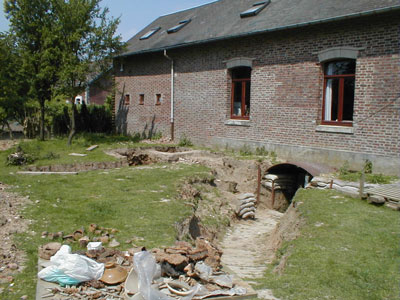 |
This is the rear of Avril's house. You can see the trenches have been excavated and the old entrance to the dressing station has been opened. All of the work being done here is supported privately by interested parties who want to preserve the memories of the events of the First World War. A number of items have been discovered -- coins, buttons, tins, clips of ammunition, medals, guns, and bones -- among other things (many are piled on the table in the foreground).
|
 |
This is the front yard of Avril's B&B. She is working hard on upgrading the facilities so she can support even more visitors.
|
 |
Avril and Lisa in the busy kitchen for one. Because it was Ascension weekend, all of her hired help was on vacation, so Avril was on her own. She made a nice lasagna dinner for the guests (which was Lisa and I and 2 Dutch families) and we all ate and talked until the sun set.
|
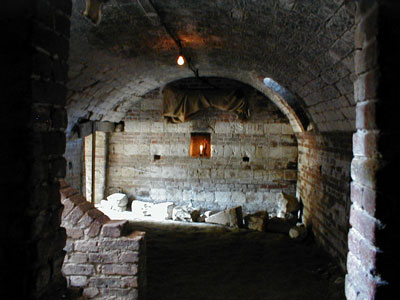 |
This is taken from inside the underground facility (under the house) looking toward the re-opened trench entrance. We can see where bunks were built up against the wall, and we were told of how the men would stay in here with the rats and fleas (on a straw floor) for protection and some warmth.
|
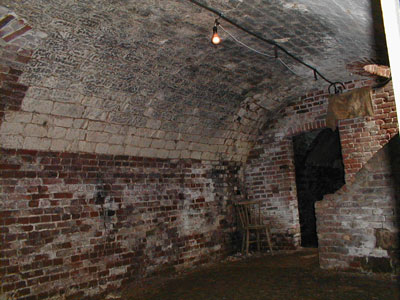 |
Looking from the trench entrance toward the back 'operating room'. Many soldiers carved their initials in the stone work, which is still visible to this day. Avril has researched the history of all of the names on the walls and knows many of their stories...fascinating.
|
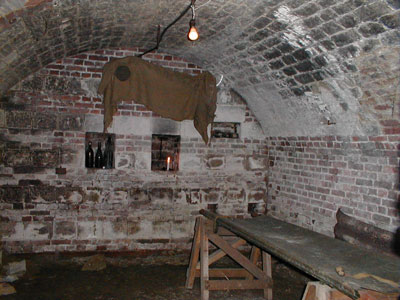 |
This is inside the operating room. You can see the operating cot on the right. A piece of metal was hung above the cot to prevent dust and mortar from falling on the patient during bombardments. The lighting in the room was a solitary 20 watt lamp. The mud floor was covered in a chicken wire mesh to provide some traction in the blood-soaked mud.
|
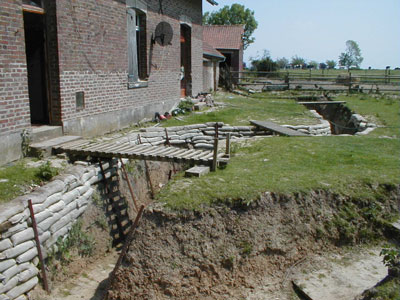 |
Another view of the trenches behind Avril's house. All houses in this area had a trench like this one connecting them to each other - primarily used for communication, and not actually on the front lines. The German lines were only about 800 yards away from here. The volunteers will be returning soon to continue excavations within the property.
|
|








